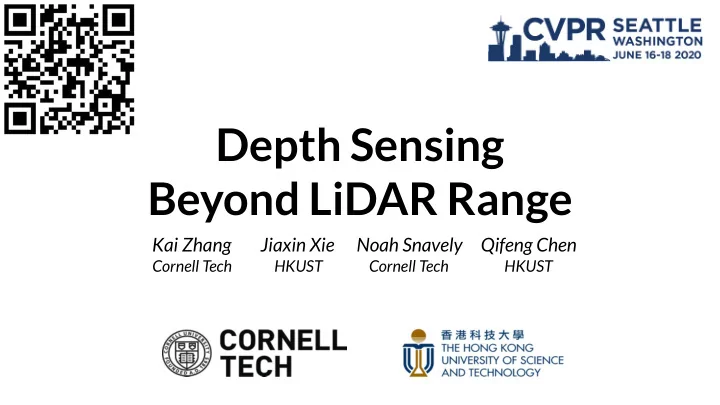

Depth Sensing Beyond LiDAR Range Kai Zhang Jiaxin Xie Noah Snavely Qifeng Chen Cornell Tech HKUST Cornell Tech HKUST
Motivation Self-driving datasets Kitti 80 meters Image sources: velodyne lidar Waymo 80 meters Question : can we achieve dense depth ... sensing beyond LiDAR range with low-cost cameras ? (e.g., >300 meters) 60 mph = 96 km/h = 27 m/s 80 meters roughly means 3 Example application: seconds Autonomous trucks driving on highway 13
Long-range depth sensing is hard { Long-range LiDAR: sparse and expensive 14
Long-range depth sensing is hard Basic idea : use two cameras with telephoto lens to capture a stereo pair, then reconstruct a dense depth map. Industrial cameras [1] Nikon P1000 Canon SX70 [1] Industrial cameras are usually much cheaper than consumer ones. 15
Long-range depth sensing is hard Important camera setup constraint: Baseline is restricted to ~2 meters because of typical vehicle size. What does this mean? Depth estimation is very sensitive to pose error, especially rotation error. It’s difficult for hardwares to achieve and maintain this precision. Triangulation angle: b=2m Relative error in Estimated depth: estimated depth 16
Tentative solution - SfM Bas-relief ambiguity in SfM [1] Big focal length → Near-orthographic camera (Weak perspectivity) [1] Richard Szeliski and Sing Bing Kang. Shape Ambiguities in Structure From Motion. In Proc. European Conf. on Computer Vision (ECCV) , pages 17 709–721. Springer, 1996.
Our approach: a new three-camera vision system Raw back view Raw left view Raw right view 18
Our approach: novel depth estimation pipeline Raw left view Raw right view Pseudo-rectified left view Pseudo-rectified right view Pseudo- Rectification Disparity Estimation 19 Estimated uncalibrated disparity
Our approach: novel depth estimation pipeline Intuition: to estimate this unknown offset, one essentially needs to know the metric depth of at least one 3D point. Pseudo-rectified left view Raw back view Offset 20
Our approach: novel depth estimation pipeline Raw left view Raw right view Pseudo-rectified left view Pseudo-rectified right view Pseudo- Rectification Disparity Estimation Offset Ambiguity Removal 21 Estimated uncalibrated disparity Estimated depth
Results on synthetic data [1] [1] Synthetic scenes might not be in their real-world scale. In experiments, we fix the baseline/depth ratio to be ~1/150. 22
Results on real-world data Pseudo-rectified left view Estimated uncalibrated disparity Estimated unknown offset Estimated final depth Ground-truth depth is acquired by the laser ● rangefinder: only pointwise measurement. Ground-truth: 302m Estimated: 300.8m ● 23
Advantages Low-cost camera-based solution; ● Not require full pre-calibration of camera intrinsics and extrinsics; ● Robust to small camera vibrations: important when mounted on moving ● vehicles. Limitations Due to lack of equipment and facilities, the system has not been built and tested ● on the road with real-autonomous cars. Our method relies on stereo matching as backbone, thus suffering from ● common issues as stereo matching, e.g., textureless areas. 24
Thank you! More technical details can be found in our paper: 25
Recommend
More recommend